Lorina Stephens's Blog, page 25
May 31, 2016
A New Site, A New Look
At long last I’ve updated my website, made it more functional, and hopefully of more interest to my loyal readers. I hope to post more often here, share my writing progress with you.
Yes, indeed, there is a very strong possibility there will be a new novel from me this year, Caliban, which is a speculative fiction which explores the concepts of beauty and reality through a thoroughly alien creature, Tine. Caliban is currently with my dear friend and superlative editor, Robert Runte. I am expecting a manuscript bleeding with revision and comment, will harrumph around the old stone house for a day or two, and then realize Robert, of course, knows what he’s talking about. Thus I will set to a revision.
I still labour away on The Rose Guardian. Truly I believe it is not only my best work, but also one which has challenged me as a writer on so many levels. It is a magic realism piece, which explores a woman’s grief upon the death of her estranged mother. The novel is told through the protagonist’s voice, Violet Cotter, from the grave by means of the mother, Una Cotter’s diaries, and through the voice of a young child known only as Lettie. For background I’ve set the novel in southern Ontario, from Paris to Manitoulin Island, from the 1930s to present day.
So, we’ll see how that goes through the year. It has been hope to have it finished last year during my recovery from cancer surgery. But it seems my enthusiasm waned under the reality of recovering. Such is the vanity of this aging woman.
Anyway, hope you like the new website. Drop me a line. Please do leave comments to let me know I’m not just scribbling in the dark of the closet and stuffing pages out under the door.
May 29, 2016
An interview with Connie Penner, author of A Town Called Forget
 Connie Penner
Connie PennerQ: Whatever inspired you to come up with the title A Town Called Forget?
CP: There is a little French town, not far from where I was born, the spelling is the same but the French pronunciation is different. I thought it was a delightful name for a story. Although the landscape of the fictional Forget is very different.
Q: So, besides the charming town, what was the inspiration for this madcap story?
CP: My twenties were particularly difficult for me, so when I began writing Forget I got quite lost in it. In some ways it was so different from my situation and in others it was very much the same. I was able to incorporate some family stories and quirks that only those close to me would recognize. For me the story was healing. A place to laugh.
Q: Can you describe your ideal reader, and for fun, can you write them as you would a character?
CP: My ideal reader has to be someone who could have tea with the Fords and find the experience delightful.
Ella and Emma Ford, young for their ninety-some-odd years, took turns reading from the Eaton’s catalogue’s dog-eared pages. They had taken to passing the evening with it since they had shipped off their Bible in the Great War. The holy book had been sent to an unknown soldier, so if he could read English, he might find solace. If he couldn’t read English or find solace at least he’d have something to trade for cigarettes. That’s why, in the sister’s minds, it was such a practical book. A book for any occasion, but now the catalogue would have to do.
“Can you read that last bit without the vowels?” Emma asked.
“I don’t think that’s a good idea,” said Ella. “It will sound too foreign.”
“Oh, use your Hungarian accent, Hungarians can’t afford vowels.”
Q: How long did it take for you to write the novel?
CP: About 20 years. I wrote and rewrote it, let it sit on the shelf for a few years and rewrote it again. Every time I learned something about the craft of storytelling I tried to incorporate that knowledge.
Q: Were there specific authors who have informed your style?
CP: That’s a hard question. I’ve been influenced by many authors. Some I’ve liked, others I haven’t. And my favourite often is the one who has carried me away at the time. If their words feel like music, they have me. It is a skill I would love to have.
Q: There are so many memorable characters in A Town Called Forget. For you, was there a favourite?
CP: I would have to say Aunt Lily. My heart hurts for her. We have all been the unlovelies of our own lives, but that poor dear has made a career of it. And I don’t think she can bring herself to live any other way. I’m a little protective of her.
Q: Among that host of unforgettable characters, was there also one you disliked?
CP: I don’t think I dislike any of my characters. But I would avoid the grocer’s wife. I’m sure she would point out more of my faults than even the most dedicated of mother-in-laws.
Q: In the process of writing, what for you came the easiest?
CP: The humour. Sometime I got so carried away, that I went quite off track.
Q: And the hardest?
CP: The plot. The first few drafts didn’t have much of one. I was having too much fun with the characters. To settle down and keep the fun while adding substance was hard for me. It was like telling a child to scrub behind their ears.
Q: Can you tell us how you were signed to Five Rivers?
CP: I heard about Five Rivers from a friend. Sent them my manuscript and two editors I know, Elizabeth McLachlan and Lesley Little, talked to Robert Runté on my behalf and he in turn talked to Lorina. My manuscript skipped to the top of the pile. It was rejected with recommendations on how to improve the story. After cleaning it up the best I could, I resubmitted and on the second pass it was accepted.
Q: And next? What are you planning for the future?
CP: I’m in a mentorship program with Gail Anderson-Dargatz. I’ve worked with her before, it was amazing. This time I don’t expect it to be any different.
 A Town Called Forget releases August 1, 2016 in both print and digital, and is available now for pre-order through Five Rivers and online booksellers worldwide. We think you will find A Town Called Forget unforgettable.
A Town Called Forget releases August 1, 2016 in both print and digital, and is available now for pre-order through Five Rivers and online booksellers worldwide. We think you will find A Town Called Forget unforgettable.



May 22, 2016
Michael R. Fletcher reviews The Mermaid’s Tale
 “He said the Arukh only had one word. It was their word for rage and for pain, for fighting and dying. It was a word spoken in sorrow and anger. It was the word they said to a world that didn’t want them, that had no place for them. It was loneliness and defiance and in the end it was sorrow and surrender. ‘Arrah’ he told me, it was all the words the Arukh needed.”
“He said the Arukh only had one word. It was their word for rage and for pain, for fighting and dying. It was a word spoken in sorrow and anger. It was the word they said to a world that didn’t want them, that had no place for them. It was loneliness and defiance and in the end it was sorrow and surrender. ‘Arrah’ he told me, it was all the words the Arukh needed.”
This book is violent and brutal and haunting and beautiful.
If I could give this a sixth star I would.
“We are born alone. We will die alone. But perhaps we do not need to live alone.”
Arrah!




Michael R. Fletcher reviews The Mermaid’s Tales
 “He said the Arukh only had one word. It was their word for rage and for pain, for fighting and dying. It was a word spoken in sorrow and anger. It was the word they said to a world that didn’t want them, that had no place for them. It was loneliness and defiance and in the end it was sorrow and surrender. ‘Arrah’ he told me, it was all the words the Arukh needed.”
“He said the Arukh only had one word. It was their word for rage and for pain, for fighting and dying. It was a word spoken in sorrow and anger. It was the word they said to a world that didn’t want them, that had no place for them. It was loneliness and defiance and in the end it was sorrow and surrender. ‘Arrah’ he told me, it was all the words the Arukh needed.”
This book is violent and brutal and haunting and beautiful.
If I could give this a sixth star I would.
“We are born alone. We will die alone. But perhaps we do not need to live alone.”
Arrah!




May 15, 2016
Artist James Beveridge discusses creative process
Hmmm…where to start? First, let me give a little space to my background and history illustrating SF&F.
I’ve been an avid consumer of all things fantastic since I was young. One of my first inspirational meetings was with Lewis Carroll’s Alice stories. While the stories were wonderful and intriguing, it was Sir John Tenniel’s illustrations that captured my imagination. They were detailed, yet nuanced, and I spent a fair amount of time gazing at them, lost in wonder. When I discovered fantastic fiction in my early teens, it was the cover visions that really got me. Since then I’ve read and enjoyed hundreds of novels and anthologies over the years, pondering how the artists connected with the stories, and tried my own ideas to see if I could find the same.
Now I get to do that, for real.
Having been an avid student of the sciences, also from a very young age, I’ve had the chance to study the earth geologically as well as the cosmos astronomically. I was also fascinated by human physiology and structure, from elementary school age and, needless to say, my notebooks were not bereft of diagrams and pictures all through my school years whether it was history, geography, physics, chemistry or biology. So, when asked to illustrate a cover, I have quite a bit of background knowledge from which I can pull a myriad of ideas and concepts to construct the components and overall theme.
Just as important as having a good-sized mental box of things, and at least a fundamental understanding of the mechanics of life and the universe around us, is making sure that the elements of the piece are accurate to the narrative. Details from the story, whether they be the settings such as landscape details or physical characteristics of the characters, must be as true to the author’s descriptions as possible. It’s taking all of this into consideration that’s important when I pick up my stylus and begin
Working in my graphics program, I begin by sketching elements from the story. I do this as a feedback mechanism to familiarize myself with characters, objects or places. These drawings help me to build a visual 3D mental image to place in tableaux that might work for a cover. For the Cat’s Pawn cover, I was given access to several chapters and reading the story gave me some visual ideas with which to start playing. I started with character studies, one for each race that stood out in the story. The first character introduced was a feline-humanoid space-travelling ambassador. I wasn’t sure how, or even whether, the fellow was dressed, so tried to strike a compromise as his native planet was hot and desert-like. I then sketched another race that appears in the story and the human about which much of the tale involves. I sent the sketches to Jeff at Five Rivers to let him see how I was seeing the characters.
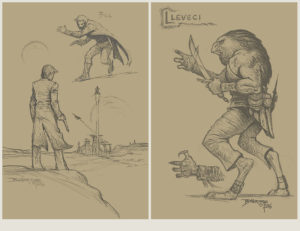 Bill and Lleveci
Bill and LleveciI also played with a spaceport concept, and from the sketches along with the title Cat’s Pawn, I came up with two separate concepts. I considered giving the spaceport idea a gameboard feel with ground lights in a grid-like layout, but the character of the Ambassador crept back and I envisioned him in front of a portal with the spaceport in view, and him standing at a holographic console that he was using as a strategic device evoking a space game. While working on that one and reading more of the source material, another concept formulated with more characters to give a bit more of a larger scope. When I sent these two in, Talan (the Oriani Ambassador) was selected. I then went to work detailing and fleshing out the scene.
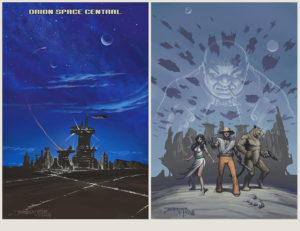 Colour concepts with spaceport
Colour concepts with spaceportFor the immediate background I went with some tech but kept it generalized in order to give it a futuristic impression but also seem integral to the normality of it and not overpowering to the scene. As for the view through the port, I tried not to specify whether the viewer was on a starship or one of the port structures, but still have fun with the buildings and ships as close-up elements from the game board of the display. While working on the ambassador, I was trying to figure out what style, if his race was prone to fabric coverings, would he wear, given he has a fur coat and clothing would be extraneous and most likely slightly uncomfortable for a desert planet.
 Original and reworked Oriani
Original and reworked OrianiAfter I sent an update to Jeff, he in turn sent it to the author who politely informed me that he should appear more leonine and the most important detail, that his race has no use for clothing. Although I had initially given him a wardrobe, I did work out his anatomy somewhat for the earlier concept with the protagonist looking down on his playing pieces. Reworking all the details then fell into place and tossing a shadow across to highlight his gaze finalized the piece.
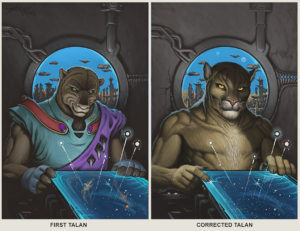 Talan first and final concepts
Talan first and final conceptsAfter finishing the cover, I went back to a couple of the earlier studies and corrected the Oriani in the sketches. Just in case I need to revisit the city.




May 8, 2016
An editor considers lack of research
 My colleague, Robert Runté, and I read and edit a lot of manuscripts in the course of a year. We often see the same mistakes cropping up.
My colleague, Robert Runté, and I read and edit a lot of manuscripts in the course of a year. We often see the same mistakes cropping up.
I thought it might be of interest to share my observations through a series of articles.
At the top of my list of writing faux pas is lack of research.
In any written work, the richness of the story is partly due to the depth of research, and therefore believability, of the environment the writer creates. Call it world-building, environmental detail, authorial authority—whatever you will, that depth of detail silences the reader’s desire to be elsewhere and acts as a lure.
What this means for the writer is a willingness to consume a broad spectrum of information, to verify that information through primary source documentation, even if that research never makes it into the final iteration of the work.
It means taking copious notes. It means writing backstory. It means slowing down, taking your time, adopting an almost Sherlockian attention to minutia.
So, if your heroine is a bowyer, make sure she’s using a credible weight and style of bow for the culture and environment in which you’ve placed her. Make sure her gear is appropriate to the time period or culture, as should be her garments. If she’s hunting, whether for sport, food or self-defence, don’t have her quarry dropping immediately into death. Why? Well, go and research that and you’ll know why. Don’t have her taking a shot at quarry 500 metres distant and expect that shot to come anywhere close to the mark. Why? Well, go and research that and you’ll know why.
If your hero is an historical character, dress him appropriately. Take the time to research the time period’s garments right from what he’d wear next to his skin, to what finery, or lack thereof, there might be for the public to consider. So, after his dip in that icy stream, what does he put on first? His shirt? Is it an 18th century shirt of coarse linen he wraps between his legs before hauling on his fall-front breeches? When he pulls on his stockings are they kept in place with leather or tablet-woven garters, or simply held in place with bits of cord? Are there buckles on his shoes, or laces, because that detail directly indicates material wealth and therefore status. Is his waistcoat buttoned with horn, leather or woven buttons? And is the waistcoat culturally appropriate? Why? Well, go and research that and you’ll know why.
When your protagonist is venturing forth into the world, what sort of conveyance is appropriate, and what would it be like to ride in or on that conveyance. I remember reading one much-touted literary work, in which an august character from ancient Greek history is writing while riding in a wagon. It was such an astonishingly badly researched moment, from an author who should have known better, I came near to an apoplectic fit. And if you need to ask why, well, go and research that and you’ll know why.
Or perhaps we’re dealing with near or far future environments. If so, make sure you are at least conversant with developing technology, and where that technology might lead, how it may or will impact our lives.
As D.G. Valdron of The Mermaid’s Tale, so eloquently put it in a recent interview: “How do we live? How do you get through the day without being killed? How do you get through the day and find something to eat? How do you raise a child that survives? More globally—how do we ensure a next generation?”
As a writer you need to become a sponge, sucking up information and knowledge with gleeful abandon. Read. Observe. Adventure into the territory of knowledge and imagination. Dare to dream. Why? Because that’s part of your job description. Fail to do so and you relegate your work to the beige realms of mediocrity. Succeed in doing so and your work elevates to the extraordinary realm of literary narcotic. And that’s a good thing.




April 30, 2016
An interview with Dorothy Pedersen, author of Canadian Police Heroes
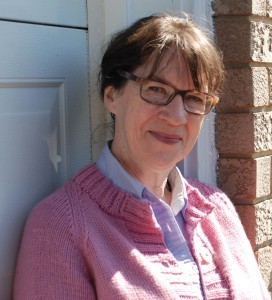 Dorothy Pedersen
Dorothy PedersenMay 1, 2016, Canadian Police Heroes releases in both print and digital through online retailers worldwide. The book is a revised and updated reprint of one author and journalist, Dorothy Pedersen, originally released through Amazing Stories in 2006. When the book was orphaned, Pedersen queried Five Rivers Publishing. We very much liked the idea of releasing a fresh version of this showcase of Canadian law-enforcement officers.
We’re pleased to present this short interview with her for your interest.
Q: Tell me about the inspiration for Canadian Police Heroes. Why write this book?
DP: As a child growing up in an industrial area of Scotland, one of our local policemen was Munroe. He always had a caring attitude when he talked to me, and would take me safely across the road, telling me not to run, or be a good girl, or something along those lines. When I returned to Scotland as an adult, I found a huge emptiness outside the entrance gates to John Brown’s Shipyard, where he normally worked. He was no longer there. I never forgot the kindness he showed me, and at a time when poor conduct in Canadian police forces was being publicized, I thought there had to be good men here too—and went looking for them.
Q: How did you go about finding the people you’ve highlighted in the book?
DP: It was a treasure hunt! I was surprised by how often my requests for interviews were turned down by police forces, or the officers I spoke to in media relations. Some people wanted to be featured in the book despite having no heroic history, but because they’d fundraised, or something like that. I did my own police work, following every lead no matter how unlikely it was to bear fruit, and came to many dead ends. However, I kept following all the leads until I got a suspect.
Q: How much did the book evolve and change while you worked on it, or was that not the case?
DP: The book was originally intended to feature stories about police officers who had received a medal, citation, or some official recognition for bravery. But police officers I was interviewing repeatedly told me about other officers who had been braver than they, and who had not been officially recognized for their actions. At first I turned down these stories, but was told about them so often that I decided to include one. I chose an officer who had been incredibly brave, saved a man’s life, but received no recognition. His story would represent those who had been ignored. Mitch McCormick’s story is my salutation to unrecognized officers.
We think you’re going to find Canadian Police Heroes fascinating.




April 23, 2016
We miss you, Shakespeare!
Today is the 400th anniversary of the death of the Great Bard, William Shakespeare. Arguably the greatest writer to have ever lived, his work is as relevant and timeless today as it was in Elizabethan England. He wrote of love and betrayal, humour and tragedy, the caprice of social mores and political figures.
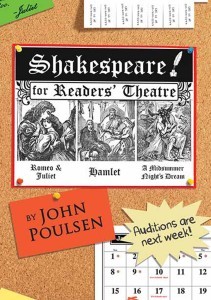
To give homage to that remarkable voice, Five Rivers is pleased to gift our readers with free eBooks for an entire week through Kobo, featuring John Poulsen’s brilliant redactions presented in Shakespeare for Readers’ Theatre: Hamlet, Romeo and Juliet, Midsummer Night’s Dream, and the screamingly hilarious modern vernacular presented in Aaron Kite’s Shakespeare for Slackers: Hamlet.
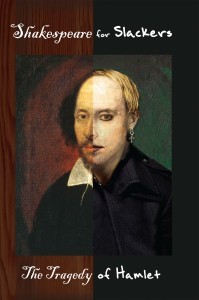
There are two more volumes in this great series: Macbeth, and Romeo and Juliet.
The second edition of Poulsen’s Readers’ Theatre series releases September 1, 2016, this one featuring Shakespeare’s greatest villains: The Merry Wives of Windsor; Othello, the Moor of Venice; Richard III; and King Lear. As in the first volume of the series, Poulsen presents several readers’ theatre versions, complete with directorial and background notes.
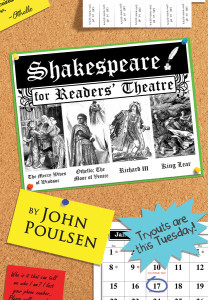
On sale September 1, 2016
April 21, 2016
Lorina Stephens to speak at CRUW Saugeen
The Canadian Federation of University Women for the Saugeen region are hosting a workshop, For the Writer in You.
The two-hour workshop is divided into three topics:
Getting Started, by author Cindy Matthews
Essential Editing, by editor Caroline Wilker
Getting Published, by publisher Lorina Stephens
CFUW Saugeen was founded in 1985, and is comprised of women from Hanover, Walkerton, Chesley, Mildmay, Neustadt, Durham and area.
Through membership dues and local initiatives, they support the advocacy work of the CanadianFederation of University Women (CFUW), a national, non-profit, non-governmental, women’s equality-seeking organization of over 9,000 members in over 100 Clubs across Canada.
For the Writer in You workshop should prove of great interest to aspiring authors in the Saugeen and West Grey regions, to be held at the Saugeen Muncipal Airport, Monday, April 25, 2016, 7:00 P.M.
April 19, 2016
An Interview with D.G. Valdron
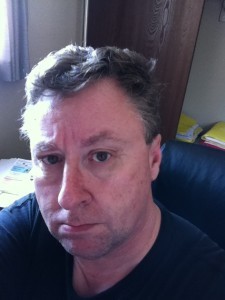
D.G. Valdron
Q: Tell me about the inspiration for The Mermaid’s Tale. What was it that informed this complex and brutal story?
DGV: It started a throwaway bit of writing—the first scene at the Mermaid’s dock, where the Arukh, fearsome, scarred, battered, terrifying but secretly afraid goes to see the Mermaids, beautiful, innocent, fearless and a little dumb. It was played for comedy. It was a bit of fun, creatures of light and darkness, and carefully subverting expectations, all the way up to a punchline. Four or five pages, an interesting character, an interesting situation, not even a full short story. Just a throwaway bit.
It sat for a few years. Then it turned into this thing, all of a sudden. Like a seed that had been sitting in a corner, minding its own business and suddenly decided to grow into a tree.
Q: You chose to have your protagonist a female. Was that a conscious decision? And why, when the world of SF&F, even horror, is so dominated by male figures?
DGV: Very much so. Part of it was subversion. Monsters and protagonists are stereotypically male. I wanted to undermine that. When I was doing the original piece on the Mermaid’s dock, I portrayed the Mermaids (Mermen?) as sexually…if not aggressive, then enthusiastic and casual. It just seemed to work better to make the Arukh female, and emotionally closed.
Honestly, the thing is, it shouldn’t matter. If something is trying to kill you, you’re not really interested in checking between its legs—that’s not going to make a difference to whether you live or die in the next five minutes. If something is trying to save you, gender isn’t an issue in whether you accept that help or not—or it shouldn’t be.
So if doesn’t matter, it can go either way. What’s important about our Arukh is her willingness to kill, and her inclination to talk instead.
I came back to the character, wrote more about her, and wrote a couple of stories about her—or about characters that were essentially her. Her gender became more important in defining the character—early sexual violence and abuse, early sexual exploration, barrenness and longing.
As I built up the world, and the biology, the female Arukhs just ended up larger and more dangerous. Arukhs are a hybrid species. Peculiar things come out of hybrid matches.
Ligers are crosses between male lions and female tigers. They’re gigantic. Something about the particular gender/species mix means that Ligers just grow huge. Tigons, between female Tigers and male lions are normal sized big cats. That seemed like an appealing idea.
Vampires in this world are essentially cattle parasites. They travel with the herds, feeding as they go. For that kind of lifestyle, not a lot of sexual dimorphism. Their evolution selects for certain kinds of strength, certain kinds of ability, that have to be universal. Everyone lives by riding with the herd.
Goblins on the other hand, have very strongly differentiated social and gender roles. They’re as small as hominid can get and still be functional. Normal humans are at the limits of what they can pass for an infant skull. As goblins reduced in size, that became a larger problem. Fewer and fewer females could successfully breed. Goblins selected for dimorphism—larger females with broad hips, and small wiry males, and organized a society resembling colonial insects—a relatively small caste of breeding females (the mothers), and a society built around caring for, sustaining and protecting the mothers at all costs.
Arukh are hybrids—universally male goblins and vampire females. The goblin heritage tends to select for massive, powerful females, relatively smaller males. They’re an inversion of the typical human pattern of larger males/smaller females. That opened up a few doors—the female Arukh are known as pejoratives Hagrik (Hags), Krohns (Crones), Hurrs (whores/horrors), sultz (sluts). I was playing with the idea that all these really negative descriptions of women in our language might be artifacts left over from different languages trying to describe these bestial hybrid women.
Part of it as well was exploring the issue of damage. The Arukh protagonist is a damaged individual. The entire race of the Arukh are, almost without exception, damaged and dysfunctional. They’re hurting, and they are blazing through life, hurting everything they come across.
But I think that there’s a paradox there—you don’t have to be damaged to be dangerous. A healthy, well adjusted, full grown tiger is incredibly dangerous and not at all damaged. The Prince in the novel is not damaged. If anything, he’s pretty well taken care of. Nothing bad ever happened to him, he’s lead a privileged, even comfortable life. It’s why he lacks empathy or the ability to see anyone around him as anything other than a toy to break.
Maybe the paradox is that we have to be damaged to be fully human. We have to experience pain and sadness to develop empathy.
Maybe its about the dodos. On Mauritius, the Island of the Dodos, they noticed that the trees were dying, and no seedlings were coming up. Eventually they realized what was happening. The seeds had to pass through the digestive tracts of the Dodos, they had to be scoured and scratched, before they could sprout. Maybe people are like that, maybe we need a certain amount of battering in life before we can become fully human.
I suppose that’s what the novel is really about. It’s about a damaged monster that goes on a journey, and becomes human through it, confronting a human being who is intrinsically a monster inside. What makes them what they are, how one changes and the other doesn’t.
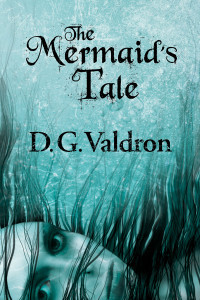 Q: Was the writing of the novel something that happened quickly, or a work to which you returned over months, even years?
Q: Was the writing of the novel something that happened quickly, or a work to which you returned over months, even years?
DGV: Hmmm. I wrote that throwaway piece, the scene on the dock, years before. I developed the world bit by bit, designed the races, even played with the character. So…years of development and thought. Mainly, it was playing with ideas, having fun.
Then, when it was the novel…. Well, that was one continuous project. I think I did it in less than a year, perhaps less than six months.
Q: Why tell this story in particular?
DGV: Maybe because the character interested me: This awful scarred monster, this creature so scraped and raw that she could casually watch a gang rape while eating lunch and feel nothing, or pretend to herself that she felt nothing. What are you, to be like that? Is there any redemption? Do we get to change? And if so, how? Or is it all predestined, its all gods and monsters, and never the twain shall meet. I wanted to explore a damaged person who could heal. I wanted to explore a creature of darkness struggling into the light.
Q: Were there authors who informed your work, or do you try to divest yourself of influence?
DGV: Honestly, I can’t think of any specific influence for The Mermaid’s Tale. I’m a huge fan of Edgar Rice Burroughs, who in his best stuff goes into anthropological levels of detail and insight. I love Roger Zelazny, particularly for his character’s casual practicality and civility, the fact that they’ll have a conversation, rather than just try and hack each other up on sight.
I hated Tolkien. I’m bored with the cliché worlds of Tolkien imitators. What the hell people? If you’re going to cover this ground, don’t just do the same thing, but shallow. Dig deep, dig deeper! Have something to say. Do something with it. I think large parts of The Mermaid’s Tale may be an outright rejection of Tolkien and the ideas he played with.
I think I’m fundamentally lazy. If someone else had written something like The Mermaid’s Tale, and done it well enough, I’d have been happy to just read that instead and go write something else. I have to write, I’m compelled. But what I write often seems to be what I want to read, if only some bastard out there had done me the favour of writing it first.
Q: How much did the story evolve and change while you worked on it, or was that not the case?
The story itself evolved very organically. I didn’t have a blueprint or anything, but I did know where she was starting from, and some of what she would encounter. I had images, events, even emotional and personal moments I wanted to describe.
I didn’t really write it from start to finish. It was like Michelangelo (I’m being pretentious), going to work on a block of marble and seeming to see the shapes inside, carving his way towards those shapes. I did chapters all over the place, here and there, and they just seemed to grow together and connect up. It wasn’t so much telling the story, as the story being all there, and I was just writing different parts of it, until in the end, it was all written.
The world she lived in, that had a lot of background development, and some of that worked to shape the story. The ‘culture hidden inside another culture’ world of female dwarves is an example. Essentially, early on, one community overwhelmed and enslaved another. But instead of vanishing, the subordinated culture, and its language, mythology and tradition, survived by becoming the ‘women’s culture’, which eventually comes to secretly dominate dwarf communities.
The world became more complex, people became more complex, everyone had a story and a history and a point of view. Every character she encounters was the star of their own movie, and she’s this bit of local colour that moves through—they meet her, they chat, they live what’s important to them, and they keep living their life after she’s gone. That kept unfolding for me.
Q: You’ve drawn from some well-known legends and mythological creatures, but realized them in a fashion I’ve not seen before. Was that a conscious decision on your part? And if so, why?
DGV: Very much so. The big question for everyone in The Mermaid’s Tale is ‘how do we live?’ How do you get through the day without being killed? How do you get through the day and find something to eat? How do you raise a child that survives? More globally—how do we ensure a next generation?
I think that was something that bothered me about Tolkien’s Evil Races, about a lot of fantasy races: There is no second generation for them. They’ve made no arrangements for child care, for raising and teaching their children, for transmitting skills and culture. Well, news flash—if your species hasn’t dealt with this, then you have no species, only a big dead end. There’s all sorts of options, sure, but then those options shape who you are and what you are.
My background was history and anthropology, I was fascinated by ecology and biology. I wanted things to make sense.
You’re a giant? That means you’re a two or three-thousand-pound omnivore? What are you eating? You’re like a biological strip mine cruising the environment! How many of you can a local environment sustain? Bears are huge omnivores, they can’t afford to be social and eat regularly, mostly they spread themselves out thin. Giants essentially are essentially hominids with the ecological footprint of bears—but bears have all kinds of adaptations to survive in their niche and be as big as they are. Giants, like bears, are creatures of their environment. How do you build up enough food surplus to have and raise a child? How do you have a culture? How does that culture find the resources to invest in children?
How giants answer that question is not necessarily the way we do. How they answer that question has a lot to do with the culture that emerges, the priorities that emerge, with how they see the world. It governs how they marry and who they marry and how their society orders things and sets priorities, how they make bargains with each other.
So it was for Goblins and Vampires, Dwarves and Selk, even Arukh. How do you get through the day? We are all creatures of our environment, shaped by our environment, defined by the need to find a niche to survive, to get along without murdering or being murdered, to find love or at least sex, to raise a child that survives and pass on whatever we are. Each race has found a different solution, one that has made them physically what they are, and which shapes their culture and world view, which shapes their inner life.
It’s just more satisfying to me. I don’t think I’ve ever been satisfied with Dwarves who just like to dig holes in mountains, and Elves who live ethereal lives.
Q: Do you find the writing process something that has to be done in isolation, or amid the flow of events?
Never really thought about.
I don’t think that I’m one of these cloistered types who can only do it when everything is perfect—you have complete peace and isolation, the right kind of pen, twenty bond parchment paper, light coming through the eastern window. Honestly, I don’t think that any writer is like that. If you’re waiting for the perfect circumstance to write, then you’re probably never going to write.
For me, I can’t not write. I have to do something. Not necessarily a novel—it could be short stories, experimental throwaway stuff, articles, essays, ransom notes. I can’t really say what or why. I can leave it alone for a while, but at some point, I sit down and start playing with ideas and words. We are compelled.
Q: Share with us what a writing day might be like for you. Is there a specific place, or music, or touchstones?
DGV: Whenever and wherever I can. I write relaxed and happy. I write because I’m upset and angry. I write because I’m bored. I write because I’m busy and need a break.
Writing is my zen. I’m not interested in sports, I’m not social in the ‘needing people’ sort of way, I’ve always been a bit eccentric and reclusive. Writing is something that balances me. I can’t not do it.
Sometimes it strikes me that there’s too many things to do, and that I should be getting work done, or keeping up to date, or fixing things—doing something more conventionally productive than writing. But frankly, if I wasn’t doing it, I’d be pretty horrible to be around. Writing keeps me safe for the rest of you.
Also, for some reason, I like writing to Duran Duran. Go figure.
Q: Is there another novel in the works?
DGV: Oh there’s all sorts of things in the works. I can’t not write.
Not sure what will come out.
It might be fun to go back to the Arukh—in the novel, she’s already quietly famous. I have a story where she gambled with the high gnomes and won. I might expand that into a novel. The gnomes are interesting, and it’s such an opportunity to explore that world further.
The war that began when she came to the city, and her part in beginning and ending that war. It’s where she meets Forty Friends.
There’s a scene in my head where some time after the events of The Mermaid’s Tale the Trolls take her to meet the oldest Troll in the world, an ancient, ancient being. And he tells her the story of how, when he was young, of the war to exterminate the Arukh—of the first genocide. He tells her of how he found and killed the last Arukh, and says ‘that’s when the killing went out of me…. the way it’s going out of you.’ She attacks him at that point, animal fury, terrified, because she knows it’s true, and she’s terrified that she can’t survive in the world as what she is becoming. And hey, Bronze needs to take her name.
But hell, I might do a Polynesian Epic on the Lost Continent of Mu (turns out there really is a lost continent sunken in the Pacific).
Or I might just write ransom notes—I hear there’s money in those.
The Mermaid’s Tale releases August 1, 2016, in print and ebook, and is available from Five Rivers and online retailers everywhere. Pre-order available.
ISBN 9781927400975,
6 x 9 Trade Paperback, 462 pgs. $62.99
eISBN 9781927400982
EPUB, $9.99




